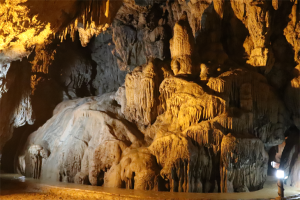Thác Bản Giốc
Thac Ban Gioc is a scenic spot located in Cao Bang province. The name Ban Gioc is derived from the Montagnard languages spoken in the area. Being is one of Vietnam’s most impressive natural sights, the waterfall is the largest in the country. The vertical drop is only 53m, with an approximately 300m span. The water volume varies considerably between the dry and rainy season – the falls are most impresive from May to September. The falls have three levels, creating a sort of giant staircase. It is a beautiful sight and should not be missed if you have time to make the journey. The falls are fed by the Quay Son river, which marks the border with China. The beautiful jade-blue body of water flows from China through a pastoral landscape of rice fields and bamboo groves surrounded by limestone pinnacles. Ban Gioc is still a relatively off the beaten path sight.

There is an impressive limestone cave system called Nguom Ngao Cave. The main entrance to this cave is 2 km from the waterfall, just off the road to Cao Bang. Actually, there are two main entrances, it is customary to enter by one and exit by the other. The cave is enormous ( about 3 km long) and one branch reaches almost all the way to the waterfalls where there is a secret entrance. Lights have been installed in the cave and the generator are turned on on whenever tourists show up. And you need to buy a ticket before exploring the cave.
Thang Hen Lake
It is located in Quoc Tuan commune, Tra Linh district, 30 km north of Cao Bang. This is a large lake that consists of 36 large and small lakes on high peaks, thousand meters above sea level. The main lake is 300 meters wide and 1000 meters long. It is a beautiful lake among lakes in the rocky mountains. This lake can be visited year round. However what you get to see varies according to the seasons. During the rainy season ( May to September) 36 lakes in the area are separated by convoluted rock formations. In the dry seasons, most of lakes, except Thang Hen itself, are dry. However, during this time of year the lake level drops low enough to reveal a large cave, which can be explored by bamboo raft.
Hang Pac Bo
 Hang Pac Bo is just 3km from the Chinese border. The cave and the surrounding area is sacred ground for Vietnamese revolutionaries. On the 28th January 1941, Ho Chi Minh re-entered Vietnam here after living abroad for 30 years. His purpose in returning to his native land was to lead the revolution that he had long been planning. For almost 4 years, Ho Chi Minh lived in this cave, writing poetry while waiting for the world war 2 to end. The reason for remaining so close to China was to allow him to flee across the border if French soldiers discovered his hiding place. Ho named the stream in front of his cave Lenin Creek and a nearby mountain Karl Marx Peak. in Tay, one of Vietnam’s minority languages, Pac Bo means “water wheel” – so called because there is a spring here.
Hang Pac Bo is just 3km from the Chinese border. The cave and the surrounding area is sacred ground for Vietnamese revolutionaries. On the 28th January 1941, Ho Chi Minh re-entered Vietnam here after living abroad for 30 years. His purpose in returning to his native land was to lead the revolution that he had long been planning. For almost 4 years, Ho Chi Minh lived in this cave, writing poetry while waiting for the world war 2 to end. The reason for remaining so close to China was to allow him to flee across the border if French soldiers discovered his hiding place. Ho named the stream in front of his cave Lenin Creek and a nearby mountain Karl Marx Peak. in Tay, one of Vietnam’s minority languages, Pac Bo means “water wheel” – so called because there is a spring here.
Narang Market
This is one of the best markets in the province. Most of the vendors and customers are local Montagnard groups including the Nung, Tay and Hmong.
Other Montagnard Markets
In Cao Bang province, Kinh are a distinct minority. The largest ethnic groups are the Tay (46%), Nung (32%), Hmong (8%), Dzao (7%), Kinh (5%) and Lolo (1%). Intermarriage, mass education and modern clothing is gradually eroding tribal and cultural distinctions. Most of Cao Bang’s Montagnards remain blissfully naive about the ways of outside world. Cheating in the marketplace, for example, is virtually unknown and even tourists are charged the same price as locals without bargaining. The following big Montagnard markets in Cao Bang province are held every five days, according to lunar calendar dates.
- ←
-
Email Us
Please send us an Email
